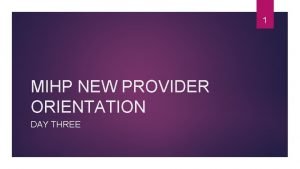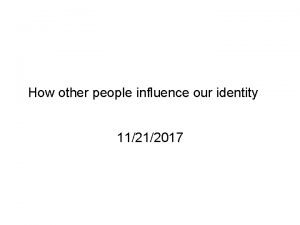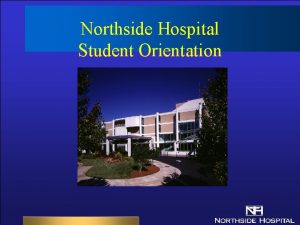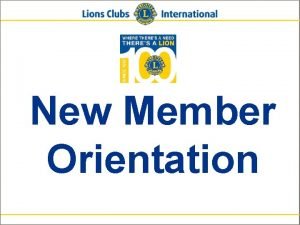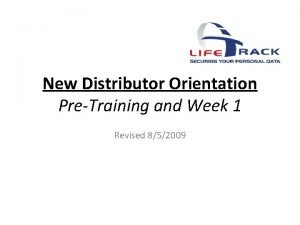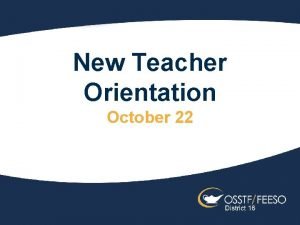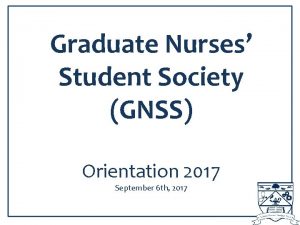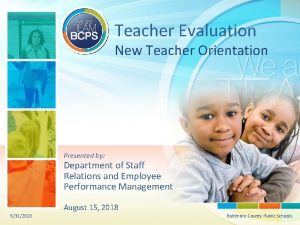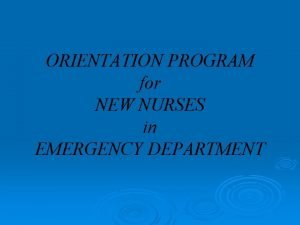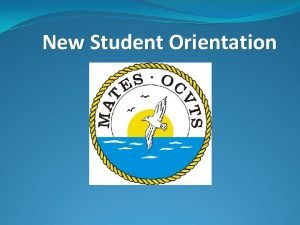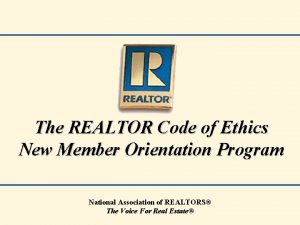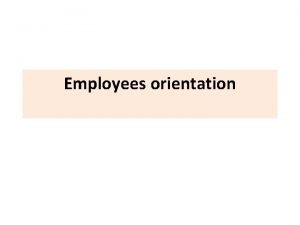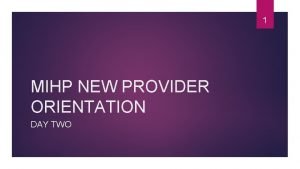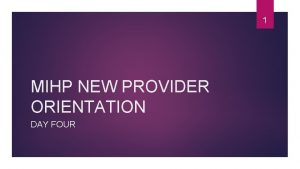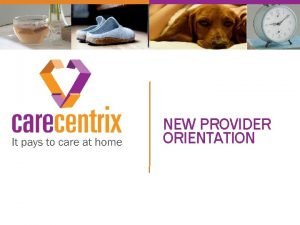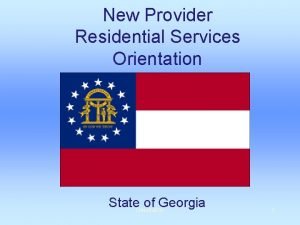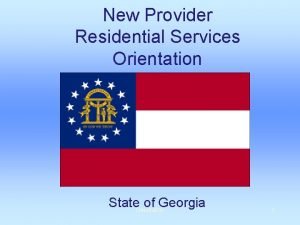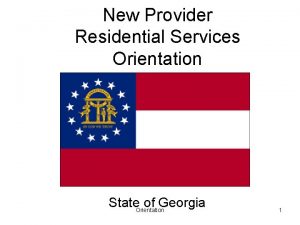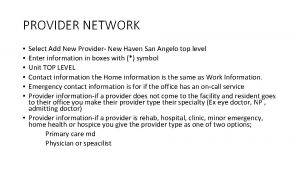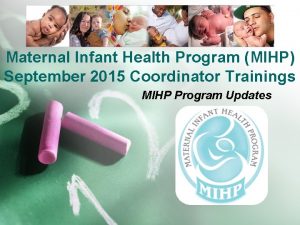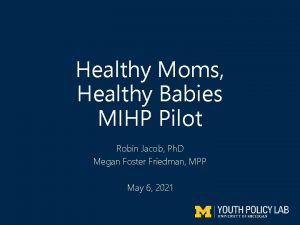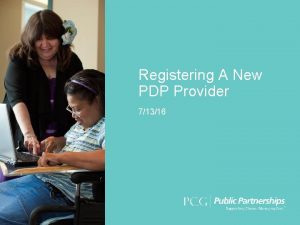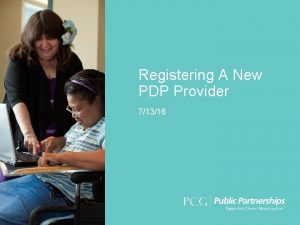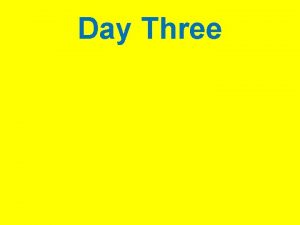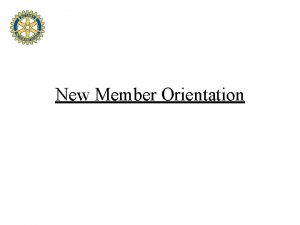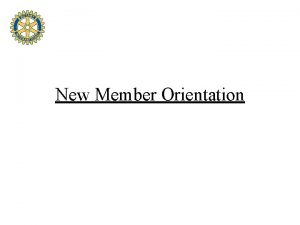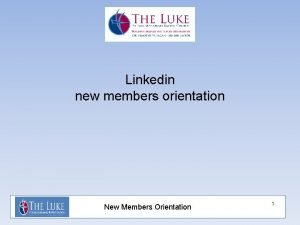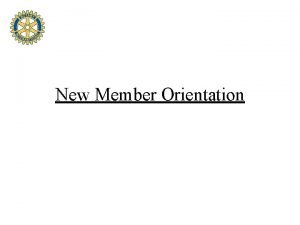1 MIHP NEW PROVIDER ORIENTATION DAY THREE 2





































- Slides: 37

1 MIHP NEW PROVIDER ORIENTATION DAY THREE

2 CYCLE 7 CERTIFICATION QUESTIONS

3 MIHP Certification Process FROM SCHEDULING LETTER TO CORRECTIVE ACTION PLAN

4 Steps in Certification Review Process Prior to Review Post. Review

5 Professionals Involved Quality Improvement Specialist Quality Assurance Coordinator MIHP Reviewer Maternal Health Unit Technician MIHP Analyst MIHP Unit Manager Perinatal and Infant Health Section Manager MIHP Staff

Prior to the Review – Scheduling Reviewers MIHP QI team schedules reviewers based on Reviewer Schedule Location of Agency Potential Conflicts of Interest Previous Reviewer Conditional Full

7 MIHP Reviewer contacts the MIHP Provider to schedule dates for review Prior to Review Documentation Maternal Health Unit Technician emails MIHP Provider Coordinator the attachments below: Scheduling letter Agenda Protocols Certification Tool Required prereview Documents

8 Prior to Review – Agency Documents MDHHS must receive all documents no later than 14 calendar days before the onsite review at mihp@michigan. gov MIHP staff forwards pre-review materials to reviewer MDHHS must receive all documents on time or this indicator is a not met

9 Prior to Review – Chart Review Selection MIHP Data Analyst and Quality Improvement Specialist review data to choose beneficiary charts to be utilized for the open/closed program and billing chart reviews 40 names provided, not all will be reviewed

10 Agenda Certification Review – two day onsite review • DAY ONE - NOTE: All requested charts must be provided to reviewer by 10: 00 AM on Day 1. • Introductions/Review Schedule for the Day • Group Staff Interview • Billing Review • Discussion of Pre-Review Findings (including protocols) • Billing Review • Program Review • DAY TWO • Coordinator Interview • Program Review (continued) • Completion of Remaining Certification Review Tasks • Exit Meeting This agenda is subject to change at the discretion of the reviewer.

11 Post-Review – Exit Meeting Reviewer will read statement: The findings verbally shared at this exit meeting are preliminary. You will receive your agency's official written preliminary findings, via email, within five business days after this review. Corrective actions should be initiated immediately after receipt of the preliminary findings for each of the Not Met indicators identified in your preliminary report. The findings listed on the Preliminary Findings of Not Met Indicators document are subject to change based on final approval of the certification report by the MIHP manager. Within 45 days of this review, you will receive your certification report and status notification letter. Reviewer will give a verbal brief summary of positive findings and areas for improvement

12 Post-Review - Documents Certification Review Confirmation Written Preliminary Findings to MIHP Provider and MIHP Certification Team within 5 business days after the conclusion of the review

13 Post-Review MIHP Reviewer emails completed Certification Letter, Certification Report, Certification Tool and Preliminary Findings to MIHP Certification Team within 14 calendar days after the conclusion of the review

14 Post-Review Maternal Health Unit Technician, QA Coordinator, and QI Specialist review certification documents MIHP Unit Manager gives final approval

15 Post-Review Maternal Health Unit Technician emails final Certification letter, Certification Report, Certification Tool and Preliminary Findings to the MIHP Provider must submit a Corrective Action Plan (if applicable) within 21 calendar days from date of the letter MIHP Provider submits Corrective Action Plan (CAP) to: mihp@Michigan. gov

16 Post-Review Maternal Health Unit Technician, QA Coordinator and QI Specialist review Corrective Action Plan Maternal Infant Health Program Manager gives final approval

AGENCY MATERIALS REVIEW Packaging Documents & Resources (For the beneficiary) Healthy Michigan WIC Agency Resources MIHP Participant Rights & Responsibilities Grievance Form Educational Packet and/or Text for Baby Agency Contact Information (in writing) Safety plan (if needed) Action plan (optional) 17

AGENCY MATERIALS REVIEW (cont. ) 18 For your records to take back to your office after completing/discussing during the visit: Risk Identifier Consent forms Plan of Care 1 Sample ASQ (for infant beneficiaries)** **helpful, but not required

Assessment Visit Discussion Introduction of the MIHP Consent to participate POC 1 Safety/Action plans (optional) Grievance Form/Rights to participate Educational Packet/text for baby Agency Contact Information/emergency in writing Mandated Reporting 19

20 Infant-Professional Visit ADMINISTERING THE ASQ-3 & ASQ SE-2

21 Developmental Screening Bright Futures ASQ-3 ASQ-SE 2 This Photo by Unknown Author is licensed under CC BY-ND

Ages & Stages Questionnaires ASQ-3 & ASQ SE 2 Parent-friendly questionnaires ASQ-3 Materials Kit Ø 20 toys, books and other items Ø Brookes Publishing at http: //agesandstages. com/ Items in beneficiary’s home Ø Available every day Ø Pass “the choke test. ” “ Go bag” giveaway 22

23 Bright Futures is a national health promotion and prevention initiative, led by the American Academy of Pediatrics and supported, in part, by the US Department of Health and Human Services, Health Resources and Services Administration (HRSA) , Maternal and Child Health Bureau (MCHB). Bright Futures questions is a screening tool developed by the American Academy of Pediatrics to determine the developmental progress of an infant.

24 Developmental Screening begins with Bright Futures! Embedded within the Infant Risk Identifier, 5 to 11 screening questions for each age range Select the age-appropriate set of questions (adjust for prematurity, if needed) Follow-up developmental screening is conducted using the ASQ tools Exception; the ASQ-3 is not administered with an infant who is younger than one month of age MIHP website--Bright Futures Re-Screening Questions

Positive Bright Futures Screen (concern is triggered) 25 If the infant is less than two months old and at least one Bright Futures “not yet” box is checked, administer the ASQ-3 within two weeks. If the infant is two months or older and at least two Bright Futures “not yet” boxes are checked, administer the ASQ-3 within two weeks If the infant is at least three months old, also use the ASQ: SE-2. Note: Infant must be at least 1 month old before you administer tool Not required to administer ASQ-3 and ASQ: SE-2 @ the same visit.

26 When to Administer the Initial ASQ-3 If no concerns are triggered by the Bright Futures screen in the Infant Risk Identifier, administer the initial ASQ-3 at the first professional visit (not the Risk Identifier visit) If the infant is not yet two months old, administer the ASQ-3 at the first visit conducted after the infant turns two months old.

When to Administer the ASQ-SE 2 27 Administer the ASQ: SE-2 using the following questionnaire intervals at the times specified below: • 2 -month questionnaire • 6 -month questionnaire • 12 -month questionnaire • 18 -month questionnaire (NOTE: You must contact your MIHP consultant for approval to serve a child who reaches 18 months of age. )

28 If the infant is older than the age limit for an ASQ: SE-2 questionnaire at the time of enrollment, use the age-appropriate questionnaire and administer it within the first 3 professional visits. ASQ-SE 2 If it is not possible to administer the ASQ 3 or ASQ: SE at the specified points in time, document the reason in the chart.

29 Why It’s Important to Administer the Initial ASQ-3 and ASQ: SE-2 as Early as Possible in MIHP

Early detection & early intervention increases the probability of a better outcome long term 30 Many infants are lost to MIHP care after only a few visits Families often appreciate the information they get from developmental screening Benefit of MIHP participation Screening appears to be a way to engage some families Children living in poverty are at higher risk for developmental delays than other children

31 Repeated screens are important for the following reasons:

32 Some developmental delays are not detectable at all stages of development Child Development is rapidly changing! Repeated screening are more accurate than a one-time evaluation Screenings at multiple ages allows for monitoring progress (or regression) Repeated screenings promote & support a parent’s understanding

33 ASQ Information Summary must be kept in the infant’s record for each ASQ-3 and ASQ: SE-2 ASQ INFORMATION The completed questionnaire (without the Information Summary) should be given to the parent A copy of the ASQ Information Summary must be provided to the parent upon request

Pulling Infant Plan of Care General Development Based 34 on Bright Futures or ASQ Scores The general infant development domain is not required for every infant General infant development will score out if a concern is identified by the Bright Futures questions in the Infant Risk Identifier (IRI) You must pull the Infant Plan of Care – General Development domain. If no concern is identified by the IRI Bright Futures questions, you may still pull this domain – professional judgement

35 Adding an Infant Plan of Care General Development after the care plan has been developed If an infant’s ASQ-3 score is below the cutoff or ASQ: SE-2 score is above the cutoff If there are two consecutive ASQ-3 screenings scoring close to the cutoff (in the gray zone) in the same developmental domain If the ASQ-3 or ASQ: SE-2 scores out in the gray zone, you may add it

Pulling Infant Plan of Care General Development after the care plan has been developed 36 Note: If there are two consecutive ASQ-3 screenings scoring close to the cutoff (in the gray area) in two different developmental domains. . . there you be is no concern on the part of the caregiver or MIHP staff do not need to add the General Development POC sure to document why you did not do so

37 When to distribute learning activities…. When an infant scores in the gray area When a family declines/refuses Early On referral This Photo by Unknown Author is licensed under CC BY-NC-ND
 Day 1 day 2 day 3 day 4
Day 1 day 2 day 3 day 4 New provider orientation
New provider orientation Day 1 day 2 day 817
Day 1 day 2 day 817 Ethnocentric orientation example company
Ethnocentric orientation example company Orientation day jennifer wang
Orientation day jennifer wang Northside hospital new hire orientation
Northside hospital new hire orientation Lions club organizational structure
Lions club organizational structure New distributor orientation program
New distributor orientation program Mlm orientation
Mlm orientation Famous toastmasters members
Famous toastmasters members New teacher orientation agenda
New teacher orientation agenda Gsu new student orientation
Gsu new student orientation Bcps teacher evaluation
Bcps teacher evaluation Emergency department nursing orientation manual
Emergency department nursing orientation manual Penn state new student orientation
Penn state new student orientation New member orientation in rotary
New member orientation in rotary Texas state university orientation
Texas state university orientation New teacher orientation presentation
New teacher orientation presentation Occ new student orientation
Occ new student orientation Fsu new faculty orientation
Fsu new faculty orientation Fsu new faculty orientation
Fsu new faculty orientation Cpcc student id number
Cpcc student id number Realtor new member orientation
Realtor new member orientation Nih new employee orientation
Nih new employee orientation Plan b santa ana college
Plan b santa ana college New employee orientation
New employee orientation Coca cola new hire orientation
Coca cola new hire orientation William beanes elementary
William beanes elementary Haiku and
Haiku and Day to day maintenance
Day to day maintenance As your room gets messier day by day, entropy is
As your room gets messier day by day, entropy is Tomorrow i don't know
Tomorrow i don't know Romeo and juliet summary
Romeo and juliet summary Growing day by day
Growing day by day Seed germination inhibitors examples
Seed germination inhibitors examples Conclusion of seed germination
Conclusion of seed germination Role of transpiration
Role of transpiration I live for jesus day after day
I live for jesus day after day

